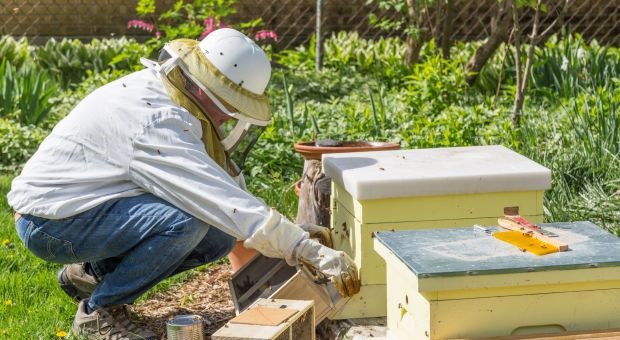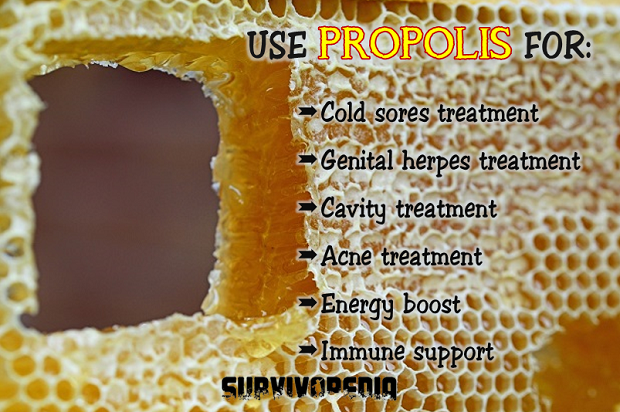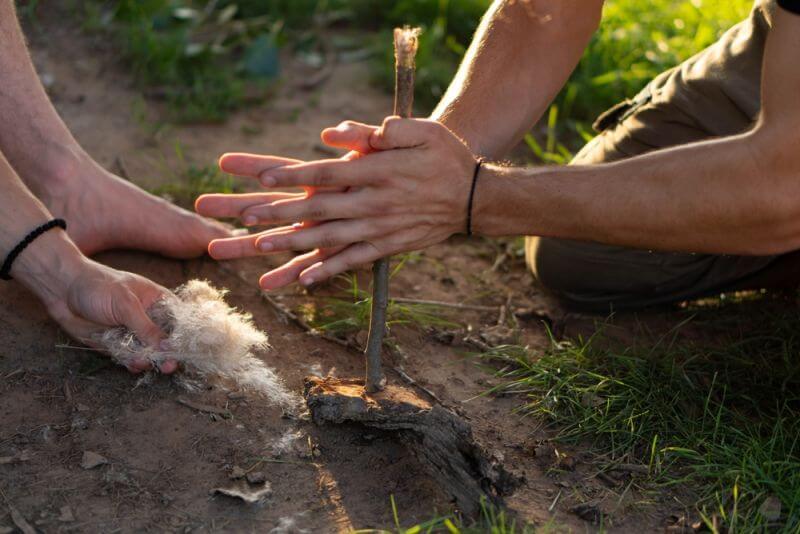Have you always thought beekeeping is a far too advanced hobby to be a realistic undertaking?
Well, think again. According to the expert beekeepers at Beemaster.com, the average commitment of time for a complete beekeeping hobby is around 40 hours per season – about the same amount of average time spent gardening.
Beekeeping requires different tasks to be completed with each season, but we’ll get to that part later. First, let’s discuss the many benefits of beekeeping to you, as a prepper or survivalist.
Beekeeping Produces Honey For Your Homestead
We all know that bees make honey, but did you know that two colonies of bees can produce enough honey for consumption for a family of four? Your location is the largest factor that determines whether you’ll have honey in your first season, but by the second year, your honey production should be in full swing. What’s more, with the incredibly long shelf life of honey, it’s one of the best foods a prepper or survivalist can keep on hand.
Organic Natural Beeswax Uses Are Seemingly Endless
Plenty of books have been written on the natural and wonderful benefits of using organic beeswax. From waterproofing and weatherproofing to first aid and cosmetic use, even if you decide not to go full on into beekeeping, beeswax is still a crucial item for preppers and survivalists to keep in bulk.
I found the DIY beeswax recipes by Wellness Mama quite intriguing. She lists soothing chapped lists, toxin-proofing your skin, Vitamin A for cell regeneration, and thickening cosmetic lotions as just a few of the many benefits of beeswax. She also shows us how to use beeswax to make toxin free deodorant, lotion bars, DIY lip balm, beeswax candles, homemade soap, baby products, reusable food wraps, cold and flu relief, and even a natural neosporin alternative.
Beekeeping As Income Or Barter
While there are clear benefits to beekeeping for personal use, many people rely on beekeeping as an income. And, with success stories boasting potential profits of $5oo per hive, it’s easy to see why! Purchasing startup beekeeping equipment and supplies is costly, but it’s easy to find a Beekeeping Community and get to know the industry and find lower cost equipment and bees.
Income potential from honeybees isn’t just from the honey they produce. Honeybees also pollinate orchards and vegetable gardens, thus greatly increasing crop yields. Selling your abundant crops is another source of income, and renting a hive to your neighbors to pollinate their crops, provides yet another income source.
Pretty exciting reasons to get started as a beekeeper, wouldn’t you say?
Now, let’s discuss the work that goes into it, so you can decide if you’ve got what it takes.
Find Here More Survival Secrets That WE Lost To History
Learning proper bee management is essential to your success, and there are several online articles, books, and classes available to get you started on your journey. Spruce writer and rural homesteader, Lauren Arcuri, shares a general beekeeper’s calendar rhythm that follows the seasonal patterns of honeybees.
You’ll need to find out how your particular region may vary slightly from Arcuri’s calendar dates. For example, Florida’s “summers” are considerably longer seasons than the ten-week Alaskan summer season. She goes on to caution that while frequently checking on your bees over the course of the year is a good idea, too much checking could disrupt their hive building and daily activities.
Looking to get started beekeeping right away? Well, you’re in luck. According to Arcuri, Spring is by far the best time to get new bees and start your first hive. It’s at this point that you’ll want to choose your hive system, gather your supplies, get hooked up with local beekeeping clubs or communities, and introduce your bees to their new home.
Spring Tasks
According to Arcuri, your bees will have consumed most of their existing honeystores during winter, so keep feeding the bees in the spring if necessary. They need to continue to have food available until nearby flowers begin to bloom to provide them with nectar.
Spring is when honey bees travel and swarm, so to avoid losing bees that travel elsewhere, Arcuri advises that you place an empty hive or two nearby in case your bees decide to swarm and look for new homes.
Once your hives are established, harvest the unused winter honey when flowers are blooming. Closely inspect your hive for the queen. She’ll have a solid brood pattern. If the queen has died, replace her. Even out your bee populations if you have more than one hive so that the number of bees is relatively equal.
Summer Tasks
Here, Arcuri goes on to give us the good news that in the summertime, your bees will basically take care of themselves. She says they’ll just need to be checked up on every couple of weeks to get ahead of any problems that have the potential for turning into larger issues.
During summer, you’ll stop feeding as by now, your bees will be in constant flight searching for nectar. Always make sure there are plenty of water sources near your hives and make sure your bees aren’t bullying. Apparently, it’s common for stronger hives to rob weaker hives.
Backyard Hives advises: “Normally you will only see robbing in the fall time, going into winter when bees, yellow jackets and others are all looking for that last source of food before winter sets in. Yet with more frequent drought conditions and warmer temperatures we are now experiencing robbing in the spring and late summer as well.”
Continue to inspect the queen frequently to make sure she is laying well.
Monitor your bees for Varroa mite infestations (these symptoms are usually apparent in the final stages of colony breakdown by the Varroa mite, and are termed parasitic mite syndrome (PMS). PMS is the name used to describe a group of symptoms, which include: Scattered brood pattern, as well as bald brood and patches of neglected and ‘dead’ emerging brood.)
Check and correct crooked combs (cross comb) if you’re using foundationless or top bar bee guardian methods. Cross comb can happen when the hive wasn’t leveled and then re-leveled a few days after the bees are installed; the spacers in the hive weren’t used correctly; or when bees build a crooked comb to compensate for an odd-angled hive.
Harvest honey – By this point in learning beekeeping, you will have learned to identify what you’re seeing when you look at the cells of each comb in each hive. After getting to know your hives, you’ll learn the differences between capped and uncapped honey comb, capped worker brood and capped drone comb. You will also recognize heater bee cells, pollen and emerged bee cells and queen cells.
Autumn Tasks
Arcuri’s task calendar teaches us that Autumn is peak time for honey collection and preparing your bees for winter. During Autumn, you’ll want to harvest honey, but be sure to leave enough honey for the bees’ winter food. To check your brood, bees need to be shaken or brushed off the comb. To shake bees off a frame first remove one or two frames which do not contain brood from the edge of the brood box, so that you can make space.
When you get to a frame with brood on it, hold it firmly by the lugs with most of the frame still suspended inside the box, and give it a short, sharp jerk down to shake most of the bees off and into the box rather than up into the air.
Check the pattern of the combs, looking for good brood patterns: As you look at the brood pattern, look for “norms”. Look, for example, for a solid block of brood being formed in the central frames. You should see areas of eggs, larvae and capped brood. There may be the occasional empty cell but, for the most part, the brood area should be reasonably solid across the foundation. Spotty coverage could be a cause for concern, since many diseases show this as a calling card.
Provided they are disease-free, add weak hives to strong ones. Autumn tasks also include reducing the entrance to the hives, putting on mouse guards and providing proper, adequate ventilation: Although many beekeepers view ventilation as a non-essential luxury, many others believe ventilation is key to long-term honey bee health and high productivity. Too much heat causes bees to congregate on the outside of the hive; too much cold can kill a colony. Too much moisture in the summer makes drying honey energy-expensive and time-consuming; too much moisture in winter can chill the bees and promote disease.
As the amount of flowering plants and nectar begin to reduce, begin to regularly feed your bees. The National Bee Unit best practices reads: “To rear brood, bees need to feed a mix of honey or sugar, water and pollen, so to encourage brood rearing: Ensure that the colonies are close to pollen crops or feed pollen. Feeding syrup excites bees and is usually done when there is no, or little, nectar flow.”
Keep the tops of your hives weighted to prevent them from blowing over in winter winds.
Winter Tasks
Here, Arcuri shares with us how she helps get her bee colony all “settled and snug for the long cold spell ahead.” Here, she makes sure all diseases are completely treated, the hives are fully sheltered from the winter wind, and she frequently monitors hives for wind damage, while checking openings to make sure there is proper ventilation.
On warmer days, she quickly opens the top of each hive to be sure the bees have plenty of honey for food, and if not, she places pollen patties or other bee food in the hives. In order to get springtime supplies and bees in time, she advises ordering them by late February or early March.
In the world of beekeepers, beekeeping is both a science and an art.
With so many survival and prepper benefits and the plethora of variations in techniques and methods, no two beekeepers are exactly the same. Every source I’ve visited advises to read, research and learn from other successful keepers to reach your highest potential. More than just a hobby, beekeeping is a lifestyle, and one that really could make you the ultimate prepper.










Armin | June 7, 2018
|
I totally agree with this article. Honey is one of nature’s miracles as are the little critters that produce it for us. This makes much more sense to me than some wacko survivalist urging us to eat bees for lunch as in an earlier article by someone else. Once I’m able to move to my permanent BUG OUT LOCATION the first things that will go in will be at least a couple of bee hives. And bee-friendly trees and flowers. Remember to plant trees and flowers that bees can use to make honey. Some bee-friendly plants are things like lavender, white clover, heather, thyme, forget-me-nots, sage. The list goes on. Anyone interested can find this out for themselves. Some bee-friendly trees are acacias, linden, black locust, catalpa, manzanita, maple, honey mesquite, sourwood, sumac, tulip poplar and willow. These are the trees that attract pollinators like bees the most. If you are going to have trees in your garden or on your land anyways why not make them multipurpose and help out the bees at the same time. Bees are already struggling enough so why not help these smallest of man’s allies. In an EOTW scenario a little honey every once in a while will help to lift our spirits, lessen our burdens and help to “sweeten” our situation.
Frank Vazquez | June 7, 2018
|
A very long and detailed article that I find informative except that I am not familiar with many of the words or terminology, but I did feel they were being used and spoken as knowledgeable bee keepers would. I would have liked to know the definitions to better understand the article.
The one thing that was not mentioned was a more passive method of cultivation. I know people create gardens to attract butterflies and hummingbords and I am sure the same could be done for bees and thus I am curious if I could put out some source of food, or grow some plants that attract the occasional couple of bees and entice them to stay and possibly form a hive either naturally or occupy one provided for them.